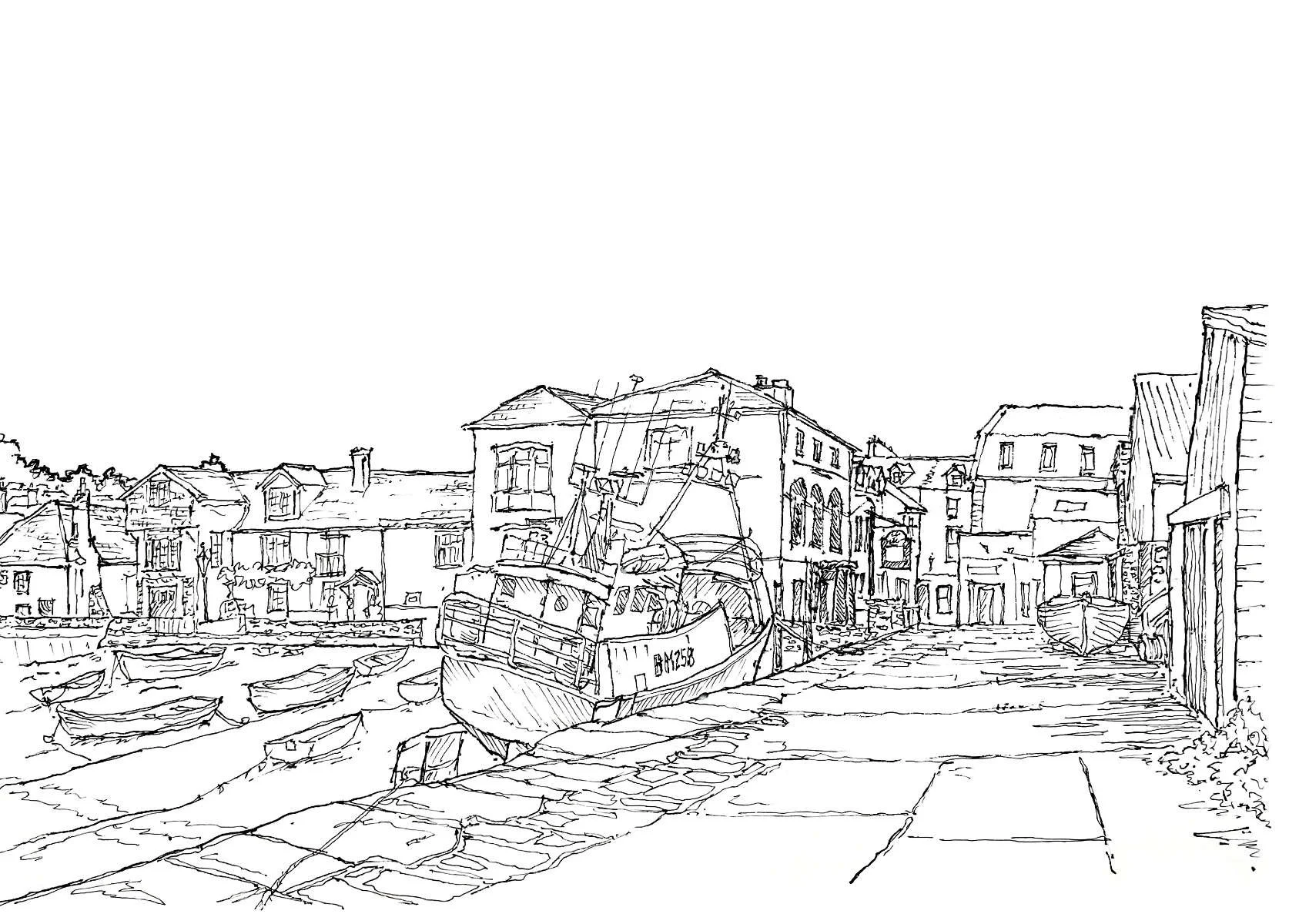The Busy and Challenging Port of Teignmouth in Devon
Teignmouth’s early port, Fish Quay and New Quay by Neil Parker.
The Port of Teignmouth is a hive of commercial activity, but navigating its waters is no easy feat. Two main organisations keep things running and safe. Associated British Ports (ABP) manages the commercial side of the port, handling various bulk materials like ball clay and animal feed.
However, the Teignmouth Harbour Commissioners act as the Navigational Authority. They are in charge of pilotage (bringing ships in safely), regulating all marine operations, managing moorings, and ensuring safe navigation throughout the harbour and estuary.
Day-to-Day Operations
The harbour features four berths (docking spots) for general cargo ships, with three on the Western Quay and one on the Eastern Quay. A feature of the port is that vessels are not always afloat; they are designed to safely rest aground on the mud and sand at low tide.
The port is an important hub for Southwest trade. Each year, it exports approximately 150,000 tonnes of clay and imports 100,000 tonnes of animal feed. Other dry bulk materials, such as stone, furnace slag, and timber, are also shipped out. Teignmouth's cargoes commonly travel to and from European ports, including Gdansk in Poland, and Ravenna and Gaeta in Italy.
The Harbour Commission employs highly skilled Ship Pilots to guide vessels into the port. These experienced mariners are crucial for navigating the River Teign's notoriously tricky estuary.
The Major Challenge: Navigating 'The Bar'
The Ness, Teignmouth estuary by Neil Parker
Getting a ship into Teignmouth Port is particularly challenging. The main obstacle is 'The Bar', a constantly shifting sandbank located at the estuary's entrance. Tides, strong currents, and weather conditions, especially strong onshore winds, mean that the depth and position of the navigable channel over 'The Bar' can change quickly.
This variability creates a serious risk of grounding, particularly for larger ships. For example, in September 2023, the tall ship 'The Pelican of London' ran aground when leaving the estuary after attending the Teignmouth Shanty Festival. Fortunately, the Harbour Pilot boat and some local mariners worked together to tow and push it free before the tide dropped too far.
Other difficulties for shipping include strong and complex tidal currents, a limited depth in the channel, and navigating through narrow sections filled with moored fishing and leisure boats.
Despite these operational hurdles, the sight of a large ship either entering or leaving the narrow channel between Teignmouth Back Beach and Shaldon is always a spectacular event, enjoyed by locals and tourists alike.
Technical Requirements for Shipping
Ships docking at Teignmouth must meet specific size and load requirements based on international regulations.
Load Lines and Seasonal Rules
Teignmouth Port is located in the North Atlantic Winter Seasonal Zone II. This designation means that during the winter period, from 1st November to 31st March, sea conditions are expected to be severe.
Consequently, any ship docking in Teignmouth during these months must adhere to its "winter" load line markings (or Plimsoll line). The load line is a marking on the hull that shows the maximum safe loading depth for a vessel in different conditions. The "winter" line is higher on the hull than the "summer" line, meaning the ship must be loaded with less cargo for its winter journey to ensure safety. The "summer" period runs from 1st April to 31st October.
Ship Size Restrictions
The Port of Teignmouth can accommodate ships up to a maximum Overall Length (LOA) of 120 metres.
Additionally, there are strict limits on the ship's draught, the vertical distance the hull is submerged in the water. Maximum draught is restricted to 5.0 metres during Spring tides (higher tides) and 4.0 metres during Neap tides (lower tides).
Finally, ships must not be loaded with more than 5,000 tonnes of cargo, a measure known as Deadweight Tonnage (DWT).
Read the Old-English Article
“Advices given of the Port of TEIGNMOUTH in the County of DEVON…”
Bibliography
Associated British Ports (no date). Teignmouth. Available at: https://www.abports.co.uk/locations/teignmouth/ (Accessed: 22 March 2025).
IMO Rules (2024). International Convention on Load Lines, 1966, as Amended by the Protocol of 1988. Available at: https://www.imorules.com/GUID-F433720D-07D7-4418-A6B1-C08A2EB5F419.html (Accessed: 22 March 2025).
Ship Nostalgia (no date). Ship Nostalgia. Available at: https://www.shipsnostalgia.com (Accessed: 22 March 2025).
Teignmouth Harbour Commission (no date). Teignmouth Harbour Commission. Available at: https://teignmouthharbour.com/ (Accessed: 22 March 2025).
IMO Rules Source. Classification Society 2024 - Version 9.40. IMO Publications and Documents - International Conventions.
Load Lines, 1966/1988
International Convention on Load Lines, 1966, as Amended by the Protocol of 1988
Annex II - Zones, Areas and Seasonal Periods
Regulation 46
Northern Winter Seasonal Zones and Area - (1) North Atlantic Winter Seasonal Zones I and II.
Available at: https://www.imorules.com/GUID-F433720D-07D7-4418-A6B1-C08A2EB5F419.html






